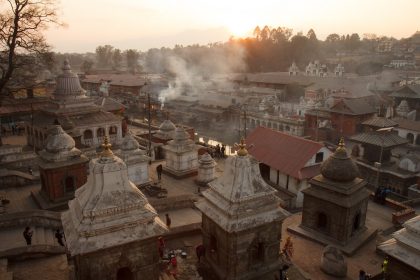
Antyeshti, the Hindu funeral rite is the last samskara of sixteen. The word “Antyeshti” means “the last sacrifice” in Sanskrit. The funeral rituals differ, depending on where the funeral is performed: in India or in the West, in England.
In India, Hindus usually cremate the bodies of their loved ones. The only exceptions are young children and saints.They must be buried instead of cremated. The funeral takes place within a few hours after the death. During the ceremony, the relatives wash the body of the deceased; the body is dressed in a clean cloth, and covered with flowers. After this, a few drops of water from the Ganges is poured into their mouth, and their body is carried over to the place of cremation while reciting mantras. Then a funeral pyre is lighted by the oldest son of the deceased. The ceremony ends with the recitation of the Hindu priest. In general, three days after the funeral, the ashes are scattered in the Ganges or another sacred river.
In England, after the death of a loved one, the family contacts a funeral home and a Hindu priest in order to perform the Antyeshti. During the funeral, the relatives and friends go first to a funeral home or chapel, where the priest recites mantras and some final rituals are performed. In some cases, the family brings the body in their own house, where the ceremony is performed, family and relatives can pay their last respect with flower petals and only then it is taken to the crematorium for the cremation. In England, some people scatter the ashes in the Thames, while others travel to India for this purpose.
After death, there is a 13 days long period of mourning. During this time, the family cannot go to the temple or perform puja (the act of worship), as they are considered impure. However, evening prayers may be recited at home. At the end of the mourning period, the Hindu priest lights a special fire (Havan/Homa) for journy the soul of the deceased. After, a sanctified meal takes place in the presence of relatives and Friends.



